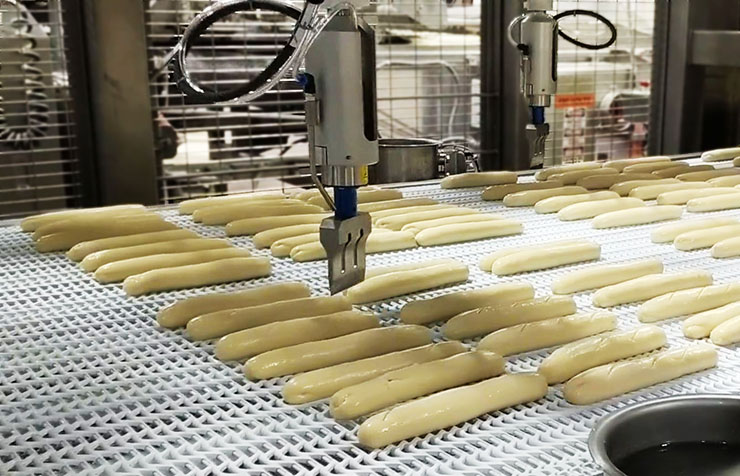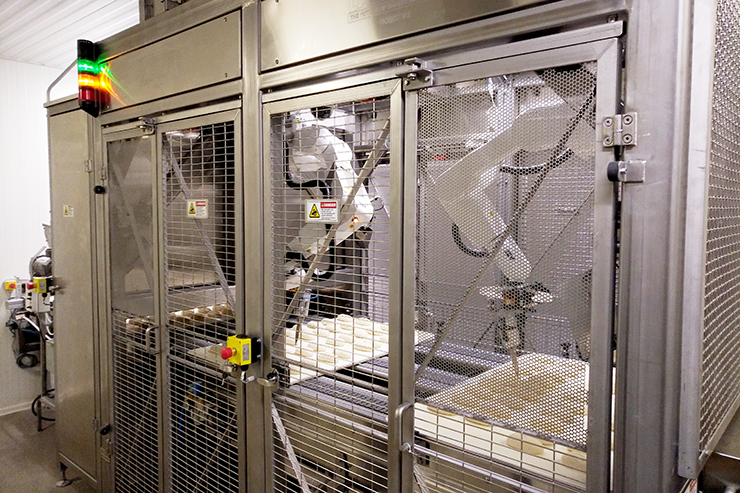
A bread’s crust is its first impression and illustrates the baker’s signature skill. Automated scoring systems can dependably reproduce the craftsmanship of a cut made by an experienced hand. Vision systems and robotics are its eyes and steady hands behind any desired patterns carved into the dough.
Automated scoring systems consistently execute cuts, using conventional cutting, ultrasonic cutting, or waterjet technology. Conventional blades are a simple and cost-effective scoring tool; they follow the shape of a product to score it with cuts made at a consistent depth. Robots can even use multiple blades of this type, as they are lightweight, which will increase production capacity – although with some loss in quality. They may tear the dough, instead of cutting it, making rough edges that, after baking, can tear the packaging. These blades need to be replaced quite often, and the disassembly and cleaning process is complex. The angle of the blade and the single cutting edge limits the possible scoring patterns. Ultrasonic blades use high-frequency vibrations to slice the dough. Dough tearing is limited with this technology, which also prevents the dough from sticking to the blade. With some limitations, the ultrasonic drag blade offers the most versatility in the range of motion, making it suitable for a large variety of products. With waterjet cutting performed by robots, the most complex shapes and designs can be made on doughs of any density, texture and size. This scoring technology excels in efficiency, hygiene and speed.
Each blade has advantages and disadvantages and, depending on the bakeries’ needs, one may be more suitable than another. The Katana robotic scoring system developed by ABI LTD incorporates a variety of interchangeable technologies for specific process requirements: conventional blades, ultrasonic drag blades, ultrasonic plunge blades, custom blades and waterjet. The different types of blades can be stored within the scoring cell for automatic tool changeover. Specialists from ABI LTD highlight the applications in which each technology excels:
+ Conventional blades are ideal when a rippled finish is desired, or for higher production rates with the multi-blade configuration. They are the ideal scoring technology for some artisan breads, rolls and buns.
+ Ultrasonic drag blades are the most flexible in terms of customizing the cut properties and can execute intricate scoring patterns. This makes them the choice for artisan breads, rolls, buns, and baguettes.
+ Ultrasonic plunge blades are the solution for faster scoring: the blade has one cutting edge with a fixed length and moves in a simple, vertical motion that can be repeated quickly. They work well with certain types of buns, breadsticks, and rolls.
+ Custom blades are an option that offers more efficient scoring, as they are developed according to specific cutting needs. ABI manufactures blades according to the requirements of the bakery and their products.
+ Waterjet scoring uses highly pressurized water as the most hygienic option for scoring. The stream of water splits the dough surface. This type of scoring offers the flexibility to accommodate a variety of scoring patterns.

The concept behind the automatic cuts
There are three important components in the Katana robotic scoring system: its vision system, the Katana platform (proprietary software), and the robotic hardware. To develop the Katana platform, ABI’s engineers combined proprietary software with a conventional programming language: “We developed our custom software to better fit the needs of industrial bakeries since solutions on the market did not exist at the time.”
ABI’s vision system continuously scans products as they enter the system, ensuring that every product is accounted for. “Using our custom-designed software, the scans are stitched together to create a comprehensive image of each product, without duplication,” ABI explains. In this way, the robot only scores each product once. When a system uses multiple robots, the Katana platform dynamically divides the workload between the robots, to balance the tasks each performs. “This capability is especially beneficial when reacting to changing conditions, such as product positioning variability. We designed a system to intelligently manage workloads and maintain their performance,” ABI’s specialists point out.
ABI developed the Katana system as custom software to support the ability to program the robots and optimize data transfer from the Katana platform. To improve efficiency and increase production speed, ABI engineers configured the scoring system to distribute the cutting workload and also streamlined data transfer from the vision system to the robot.
Automation is built into its design: automated tool changeovers eliminate safety risks (inherent with manual hand-ling) and execute the desired swap between various end-of-arm tools in a matter of seconds. On the user interface, the operator simply selects the appropriate recipe (scoring pattern) in the Katana system. If the new recipe requires a different type of blade, the robot uses the automatic tool changer to switch the blade. Now the system is ready to receive the incoming product.
As the Katana platform analyzes data from the vision system, it can also perform quality control as it detects flaws, inconsistencies, or substandard qualities, such as over-proofed dough. Through the user interface, operators are then alerted, so they can adjust the relevant upstream or downstream processes. ABI is in the process of development the feature to automate adjustments to relevant operations. “As a future development, the Katana platform will have the capability of communicating with the relevant upstream system to correct or adjust relevant settings or with the downstream systems to address substandard products, in real-time.”
“Our vision platform uses machine learning algorithms and multiple vision sensors to image, process, and analyze a variety of products.”
ABI LTD engineers
The vision
The Katana platform uses visual data to determine how to execute cuts properly. That information is communicatedto the robotic arm(s), which then performs the cut as determined by Katana. Katana’s vision system uses 3D scanning to determine the topography of each product and if any products are touching or overlapping. Laser technology is used for 3D scanning to create a ‘point cloud’, a set of 3D data points, for each product (a similar process is used for satellite earth mapping). “With each data point, the Katana platform can accurately determine the shape and features of the product’s surface. This data lets us execute the scoring pattern very precisely each time,” ABI details.
In addition to 3D scanning, ABI’s vision system has many capabilities that are utilized in other processes of industrial baking, such as inspection or pick and place. This robust system has the ability to generate a complete view – outside and inside – of scanned products, which is essential to effective processing and automating robotic product handling. The vision platform is built to observe, analyze, and react to real-world conditions. Real-time data analysis prompts actions automatically. “Our vision platform uses machine learning algorithms and multiple vision sensors to image, process, and analyze a variety of products,” they explain. Product recognition algorithms were developed for bakery products, including bagels, baguettes, boules, buns, and pastries. The vision platform can identify product types with a 98% success rate, even when products are touching or overlapping.
ABI’s vision system combines images from multiple sources to provide a comprehensive picture of a product’s state. “It accurately identifies surface features and product characteristics and can capture thermal or x-ray imaging,” ABI elaborates. Custom software was developed to synchronize 2D and 3D cameras, by taking pictures simultaneously at the required rate. An algorithm was developed to identify features from each image source. “Our engineers superimposed 2D onto 3D captures to create a defined image of product characteristics and facilitate comprehensive product analysis,” we learn. This capability was not available on the market at the time, ABI points out. This is how touching products are detected and product shapes are identified, to guide the robot’s movements.

Perfecting the cut
To add scoring patterns to the Katana platform, bakers will enter and save the product dimensions and the properties of the desired cut. Unlimited scoring patterns can be saved. The recipe matching the running product is loaded, to begin scoring. No prior training is required to operate the system, ABI explains: “We designed Katana so bakeries can easily and quickly adapt robotic technology in their production.”
The Katana platform automatically adjusts the scoring pattern to accommodate product variability. It will ensure precise cuts, consistently, its developers explain. The platform optimizes the robot’s scoring path to maximize the ratio of cutting movements over positioning movements. Taking into consideration product positioning (arranged or randomized), the scoring pattern, the complete travel path, the Katana platform determines the optimal way to execute the cuts to increase efficiency, while minimizing the wear and tear of the machines.
In addition, dip tank cleaning can be scheduled at regular intervals, to maintain hygiene. Katana also has the capacity to communicate with upstream systems regarding upcoming workloads, to schedule cleaning cycles automatically. Bakeries can determine a dip tank cleaning routine that best supports their production schedule. “We can also program specific positions for the robot to streamline any maintenance or cleaning tasks,” ABI mentions.
The Katana system can operate as a stand-alone machine for lower production volumes (products need to be manually fed into/removed from the machine). ABI recommends incorporating the system, customized as needed, into a turnkey line to realize its full potential.
“Since it is also a flexible system, it can accommodate future product needs too,” the specialists note. Aside from the scoring blades, the robotic arm is compatible with other end-of-arm tools (EOATs), such as soft grippers and vacuum grippers which can extend its functions into pick-and-place operations as well (e.g., product reorientation, or board loading/unloading). This allows bakeries to change the Katana system to execute other applications and maximize the functionality of the equipment.
To design custom setups, ABI engineers analyze a bakery’s production process. Here are some examples of what can be customized:
+ The conveyor can be built with widths up to four meters to facilitate its placement on production lines. A four-meter wide conveyor is ideal for loading scored products directly into the oven.
+ The mounting angle of a tool (how slanted the blade is when inserted into the product) is adjustable. When combined with the range of movements of the robot’s wrist, it expands both the product range and pattern diversity.
+ The UI can be personalized by adding buttons to quickly access specific views or data sets.
Several scoring characteristics can be controlled by the Katana platform, including the compound angle, the plough angle (the blade angle as it executes a cut), the depth, the length of a cut, the spacing between cuts and the amplitude of the high-frequency vibrations, for ultrasonic cutting.
Consistency is ensured by the product-specific information retrieved by the vision system. “The Katana robotic scoring system uses visual data to map the scoring pattern and makes adjustments to accommodate any variations. It then communicates to the robot how to exactly execute the cut.”


